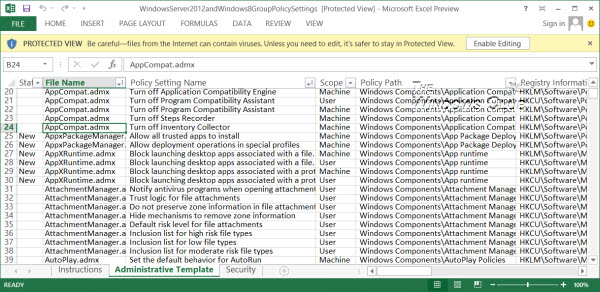The Group Policy is an integral part of the Windows operating system, on which many an IT Pro, Beginners and Tweak enthusiasts count on to customize and enforce settings on their computers. The Group Policy Editor (Gpedit.msc) is one of the most useful tools for administering policy on Windows.
The Group Policy Editor, however, is not included in every edition of Windows. For instance, in Windows 10, The Group Policy is not included in Windows 10 Home Edition. In Windows 8, the Group Policy is included only with Windows 8 Pro and Enterprise Editions. While Windows 7 Ultimate, Professional, and Enterprise editions have it, Windows 7 Home Premium, Home Basic and Starter Editions do not include the Group Policy Editor.
Group Policy Settings Reference Guide for Windows 10

Looking for the latest Group Policy Setting Reference for various versions of Windows 10? These spreadsheets list the policy settings for computer and user configurations that are included in the Administrative template files delivered with Windows 10/8.1/7/Server.
Microsoft has updated and made available as a download, the complete Group Policy Settings Reference Guide for Windows 10, Windows 8.1, Windows 8, Windows 7, Windows Vista, Windows Server 2016, Windows Server 2003 SP2, Windows Server 2008 R2 and Windows Server 2012 R2. The download is available in the form of spreadsheets for different operating systems. So you can download the spreadsheet only for that operating system/s which you may be interested in.
The Group Policy Editor offers filtering options. These spreadsheets too, offer filtering capabilities, that will let you view a specific subset of data, based on one value or a combination of values that are available in one or more of the columns.
These spreadsheets list the policy settings for computer and user configurations that are included in the Administrative template files delivered with the Windows operating systems specified. You can configure these policy settings when you edit Group Policy Objects.
What is also very useful in these spreadsheets, is that it also lists the registry keys which are affected when the settings are changed. Of course, you can always use the Group Policy Settings Search, to know the registry key and value name that backs a particular policy setting, but these spreadsheets put them all in one place.
Read: How to reset Group Policy to default.
The Administrative Template spreadsheet contains three columns that provide more information about each policy setting’s behavior related to reboots, logoffs, and schema extensions. These columns are the following:
- Logoff Required: A “Yes” in this column means that the Windows operating system requires the user to log off and log on again before it applies the described policy setting.
- Reboot Required: A “Yes” in this column means that the Windows operating system requires a restart before it applies the described policy setting.
- Active Directory Schema or Domain Requirements: A “Yes” in this column means that you must extend the Active Directory schema before you can deploy this policy setting.
- Status: A “New” in this column means that the setting did not exist prior to Windows Server 2012 and Windows 8. It does not mean that the setting applies only to Windows Server 2012 and Windows 8. Refer to the column entitled “supported on” to determine to which operating system the policy setting applies.
Download it from Microsoft.
Read: How to search Group Policy for specific GPO in Windows 10.
Useful links:
- Group Policy Settings Reference Spreadsheet & ADMX Templates for Windows 11
- The Group Policy Settings Reference Spreadsheet for Windows 10 v21H2 can be downloaded here
- The Group Policy Settings Reference Spreadsheet for Windows 10 version 20H2 can be downloaded here.
- The Group Policy Settings Reference Spreadsheet for Windows 10 v1909 and 1903 can be downloaded here.
- The Group Policy Settings Reference Spreadsheet for Windows 10 v1809 can be downloaded here.
- The Group Policy Settings Reference Spreadsheet for Windows 10 v1803 can be downloaded here.
- Download Administrative Templates (.admx) for Windows 10.